|
Related FAQs: Mussids, Mussids
2, Mussid Identification,
Mussid Behavior, Mussid Compatibility, Mussid Selection, Mussid Disease, Mussid Systems, Mussid Feeding, Mussid Reproduction, Stony/True Coral, Coral System Set-Up, Coral System Lighting, Stony Coral Identification, Stony Coral Selection, Coral Placement, Foods/Feeding/Nutrition, Disease/Health, Propagation, Growing Reef Corals, Stony Coral Behavior,
Related Articles: Large Polyp Stony
Corals, Stony or True Corals,
Order Scleractinia, Dyed Corals,
/The Best Livestock For Your Reef Aquarium:
Brain, Meat, Pineapple
Corals, Family Mussidae, pt. 3
To:
Part 1, Part 2, Part 4,
Part 5, Part 6,
Part 7, Part 8,
|
Bigger PIX:
The images in this table are linked to large (desktop size)
copies. Click on "framed" images to go to the
larger size. |
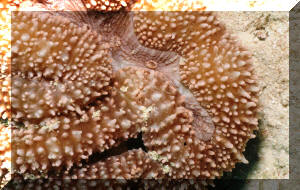 |
|
|
By Bob Fenner
|
|
Genus Lobophyllia Blainville 1830. Lobed/Flat Brain Coral.
Sometimes massive colonies that tend to be dome-shaped.
Flabello-meandroid, meandroid or phaceloid. Large corallites single or joined into
meandering units, circular or in long valleys; with distinctive
tall, knobby, long septal teeth. Fleshy mantles that can contract entirely (e.g.
when exposed to air at low tide). Valleys (columellae) long and deep, often of
contrasting lighter color. Tentacles typically light tipped.
| Lobophyllia corymbosa (Forsskal
1775). Colonies flat to hemispherical, large in the Red Sea (up to six feet
in diameter). Usually singular corallites, but may have 2, 3 joined together
on occasion. Well separated calices. High, blunt septal teeth. Colors are
generally greenish or brown, gray, with lighter oral discs; look spiny. Below: Red Sea broken colony and
two groups growing near, close-up, N. Sulawesi |
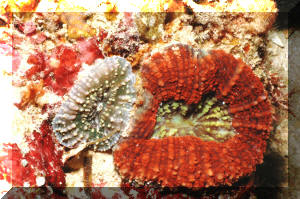 |
| Lobophyllia flabelliformis Veron 2000.
Hemispherical colonies that readily break apart. Very fleshy
corallites. Mantle covers all skeletal elements. Fully expanded
colonies exhibit papilla that look like small tentacles over septa.
Aquarium specimen. |
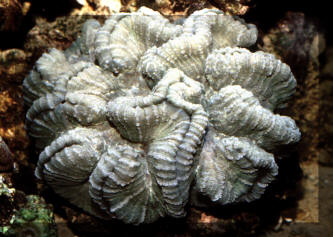
|
| Lobophyllia hataii Yabe & Sugiyama 1936.
Flabello-meandroid at edges of colonies, meandroid in centers. Shallow
valleys w/ flat floors. Typically brown or green with contrasting valleys.
Bali 2014 |
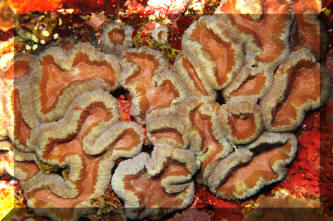
|
Bigger PIX:
The images in this table are linked to large (desktop size) copies.
Click on "framed" images to go to the larger size. |
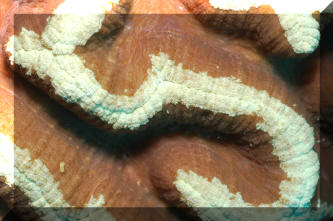 |
| Lobophyllia hemprichii (Ehrenberg 1834).
Flat to huge dome-shaped colonies of more than fifteen feet
diameter. Elongate, irregular corallites, often with contrasting
oral disc color. A common species where found. Easily kept in
captivity and fragged. At right, aquarium colony and small colonies
from the wild are often marketed at retail. Below, a close up and a
colony in Pulau Redang, Malaysia, and a just-picked-up specimen by
the author in Fiji. Second row, N. Sulawesi. Third row, specimens
in Nuka Hiva, Marquesas, Polynesia. |
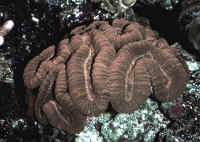 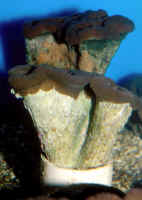
|
Bigger PIX:
The images in this table are linked to large (desktop size) copies.
Click on "framed" images to go to the larger size. |
%20MD.JPG) |
| Lobophyllia pachysepta Chevalier 1975. Small
colonies either flat or hemispherical. Distinctive large lobed,
yellowish teeth (handful) per corallite. Gray, green in color.
Fiji, N. Sulawesi photos. |
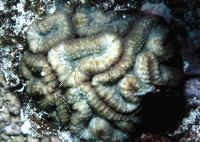 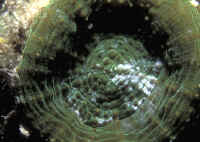
|
Bigger PIX:
The images in this table are linked to large (desktop size) copies.
Click on "framed" images to go to the larger size. |
 |
| Lobophyllia serratus Veron
2000. Hemispherical colonies of up to six feet across. Meandering
corallites bear 2 or 3 mouths. Septa with tall, sharp teeth
(evident on dead polyps). Distinctive flattened, tri-colored
appearance to living corallites. Hawai'i (Waikiki) aquarium
photo. |
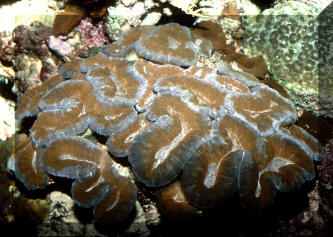
|
| Lobo's come in many, MANY color variations: |
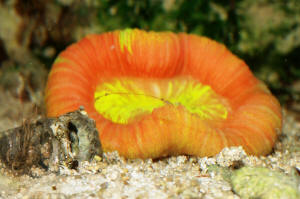
|
To:
Part 1, Part 2, Part 4,
Part 5, Part 6,
Part 7, Part 8,
|
|

